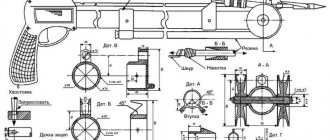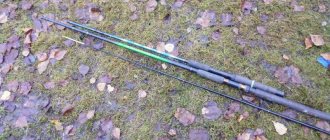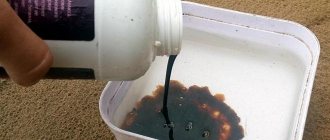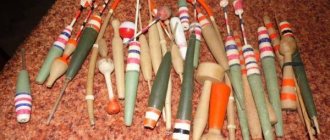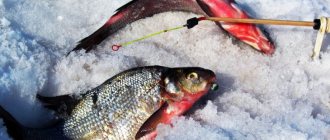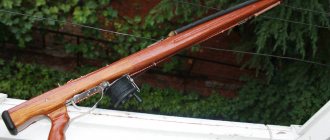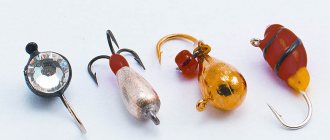What are jigs
It has long been known how the quality of bait affects fishing success. Jigs for winter fishing are artificially created baits that, thanks to their special shape and wiring, attract fish.
The jig is easy to describe:
- a hook is attached to the weight;
- artificial bait is attached to a fishing line without a leash;
- There is a wide variety of jigs for winter fishing.
The popularity of jigs in winter is due to a number of factors. Firstly, in winter any fish bites on it. Secondly, this is inexpensive gear available to everyone.
What kind of fish is caught with a nail cube?
Initially, the device was created for winter fishing. However, experienced fishermen note that the nail cube is a jig for catching ruffe and sorog from the ice. Perch, roach, bream, rotan, and silver bream actively bite on this reelless fish. The noise from the cube and proper wiring attract the attention of small perch and pike.
Gear used
The winter fishing rod for reelless fishing is 30 cm long and equipped with a closed-type reel and a comfortable handle. An open reel has a disadvantage: the line may freeze in it if the fishing rod is placed on ice. This element of the tackle must be free to rotate and lock securely when the nut is tightened. In a purchased fishing rod, the hole on the reel has a small diameter. For ease of use, the tackle is expanded using a thin drill or a hot awl.
The best material for a fishing rod handle is porous rubber. Cork and porous foam behave well in the cold. This handle is warmer than a plastic or wooden one. The hook can be easily inserted into it.
The whip for winter tackle is made of frost-resistant plastic. To prevent the fishing rod from getting lost in the snow, it is preferable to choose a device painted in a bright color.
The best materials for the nod are considered to be lavsan and steel strip. The first ones are more sensitive, they immediately transmit the slightest movement of the jig, do not rust, do not freeze, but are highly susceptible to wind. The latter are resistant to wind, making it easy to distinguish a bite from the impact of a gust of wind on the line. However, steel strip nods convey the jig's play worse.
Types of jigs
An experienced fisherman keeps different types of jigs in a box.
Summer and winter baits
Summer and winter baits differ in weight. In summer, the upper layers of the reservoir are filled with fry, which attack any bait, which means they do not allow it to reach the bottom, where large fish swim. To protect the bait, summer jigs are made heavier than winter models.
In summer, the water in the reservoir is more cloudy, so the color of the jig should be brighter.
The winter jig is smaller in size than the summer bait. This is necessary so that the bait looks more believable in clear water.
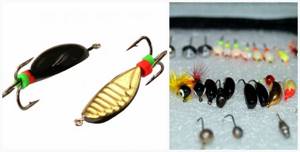
Moths and mothless
Bloodworm is the most catchy bait. This bait is very delicate, which means it is not difficult for the fish to knock it off the hook. Experienced fishermen start fishing with reelless reels and then switch to baits.
Mothless fish resemble insects that are part of the fish’s diet, so it bites without fear. For better attractiveness, the bait is decorated with shiny threads. In some cases, sprays with a special scent are used. Moths with an animal bait increase the chance of a bite, since the fish have a well-developed sense of smell.
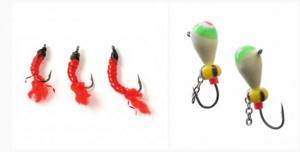
Form
The behavior of the bait depends on the shape if there is a current or standing water. A jig with a teardrop shape when inserted imitates an insect caught in the water. This bait is usually attacked by perch and ide.
The flattened jig resembles a butterfly. When wiring near the bottom, a cloudy cloud is created. It attracts curious fish.
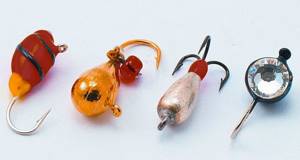
Weight
Since reservoirs come in different depths and with different current intensities, baits are needed that will have different weights. They are made light, medium weight and heavy.
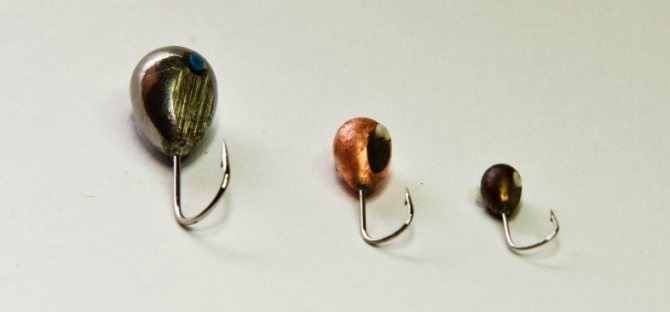
Cargo material
To make the bait sink faster to the set depth, it is made heavier. Tin, lead, and tungsten are used as weighting materials.

Color
To make the jig attractive for winter fishing, it is painted in different colors. Due to refraction in the water column, the color of the bait changes. At great depths, red and yellow colors are clearly distinguishable. Each type of fish has colors associated with food. For example, roaches have black, white and orange colors. Predatory fish are attracted to black, red and yellow colors.
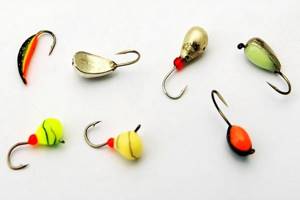
Hooks
Jigs use from one to three hooks. Thin hooks have advantages, but they cut the fish’s lips and the catch is lost. In a standard jig, the forearm and sting form one plane, but a hook with a bent sting is needed for predatory fish.
A jig with a nozzle should have a long fore-end to better hold the bloodworm.
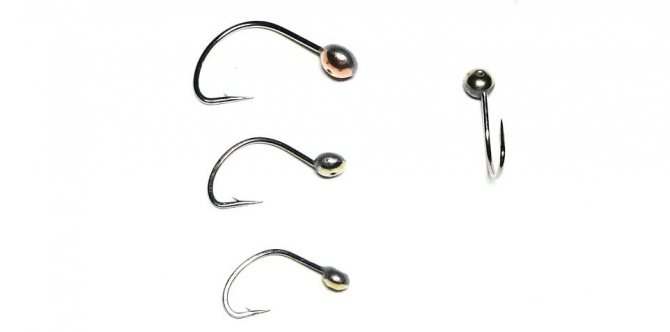
Black Widow is in action. Maximus "Black Widow" 24ML.
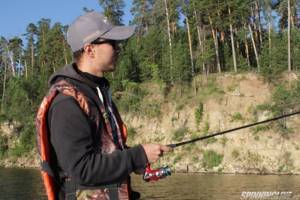
And so, on the eve of the autumn season, when the climate becomes colder and the fish leave their shelters and slide into deeper places, the time comes for jig fishing and heavy baits. It's time to talk to us about another spinning rod from, which is perfect for this fishing season and will cover the necessary range of required characteristics. We started testing this spinning stick even before the start of the warm summer season, and we can say with confidence that it is universal. When I had the first opportunity to hold it in my hands, it immediately fell into my hand - the extraordinary lightness of the blank, the comfortable handle, it just fit perfectly in my hand and made it easy to manipulate the rod. However, this was only a priori my sensations and I eagerly wanted to experience it in practice.
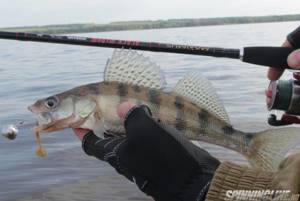
We had the first opportunity to test this model at the opening of the summer season, when we were invited by our friends and colleagues of a common hobby from the KZN-FISHING fishing base, located in the Alekseevsky district near the village of Sakony, where the bank of the Kama River was located. These places were conducive to jig fishing, so we immediately decided to start with it. We used collapsible “Cheburashka” type weights up to twenty-four grams - slightly exceeding the test form. Then we managed to successfully catch medium-sized pike perch and bersha, which after a short photo session were safely released back to their native element.
Briefly about the characteristics of the model: the spinning blank is made of high-modulus IMSE graphite, which gives it good sensitivity and lightness. The fittings consist of Kigan Zirconia rings, which are arranged according to the modern 3D-Guide System concept, and Mini Guide System micro-rings are also used. The butt consists of a Fuji reel seat and an ergonomic neoprene handle.

With the onset of warm days, aquatic vegetation grew more and more on the reservoirs, and we could not resist the temptation to fish with this model using surface baits using the twitching method. However, you can fish, but we felt slight discomfort due to the length of the spinning rod - it was too long for this fishing method. However, you can practice short sets of twitching, combining it with other types of fishing when really necessary. Otherwise, it can lead to hand pain in the wrist area.
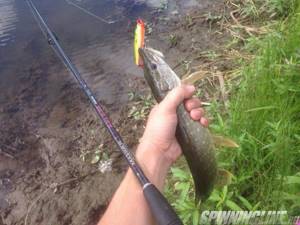
The “Black Widow” model, as practice has shown, skillfully copes with fishing with spinner spoons - excellent sending qualities allow you to catch without moving from your spot and cast to the required fishing horizon. Despite the rigid blank, this stick successfully copes with the resistance of the fish, effectively dampening its jerks.
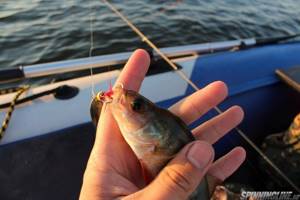
Despite the stated versatility of this model, we note that this stick is best suited for jig and spinner fishing. Yes, we tried fishing using the twitching method, but it is extremely inconvenient to animate with a bait with a length of 244 centimeters. However, fishing with twitching is quite possible if these are short sessions with a combination of other types of bait.
Happy fishing to everyone on the reservoirs, with respect Sergey Egoist. Fishing club "Kamfish"
Tungsten jigs for winter fishing
Tungsten is used to weight the jig.
Among the advantages of such artificial bait are:
- If the lead jig is large, then tungsten jigs for winter fishing are much smaller. At the same time, they are heavier than the lead version due to their density. Even with strong currents, equipment with a tungsten jig quickly sinks to depth;
- tungsten paints well due to its structure;
- due to its small size, the bait provides a believable game that attracts any fish;
- the strength and reliability of tungsten jigs allows them to be used for a long time;
- the high catchability of jigs and environmental safety compensate for the higher price compared to the lead version.
Tungsten is a refractory metal, so a jig can only be made from it by turning it.
{banner_vnutri-kontenta-3}
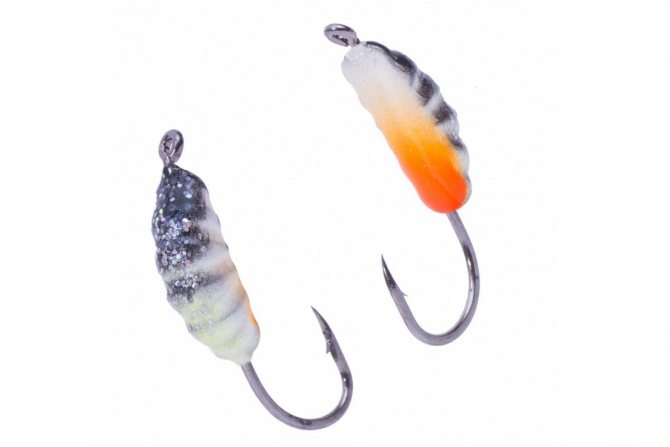
Reelless or nozzle-less jig
Nozzle-less jigs, called reelless jigs, compete well with live bait. To fish with such a bait, you need to practice, since the wiring technique is crucial for successful fishing.
Popular catchy reelless jigs for winter fishing include:
- “Uralka”
- A classic jig, shaped like a curved drop. Thanks to this form, it is distinguished by independent play. The hook is attached to the narrow part. Made from tungsten or lead weighing from 0.4 g. Covered with silver, gold, black;
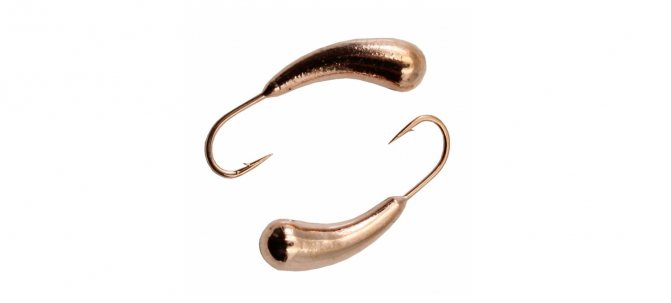
- “Devil”
is a vertical jig that resembles an elongated drop with a soldered tee. Gives good results when catching predatory fish. Made from tin, lead and tungsten. It weighs from 0.2 g. They are painted silver, golden, black;
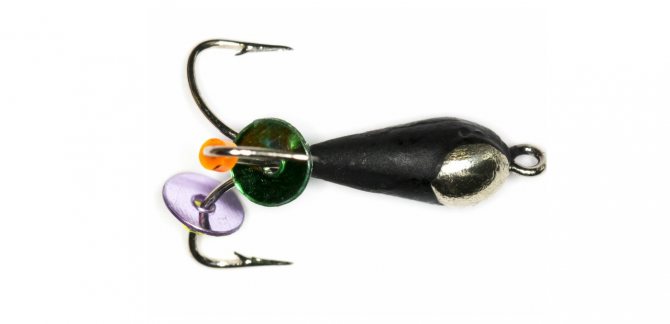
- “goat”
is a universal under-ice bait, similar to “Uralka” with only two hooks. When retrieved, it moves like an amphipod. Made from brass and copper. It weighs from 0.2 g;
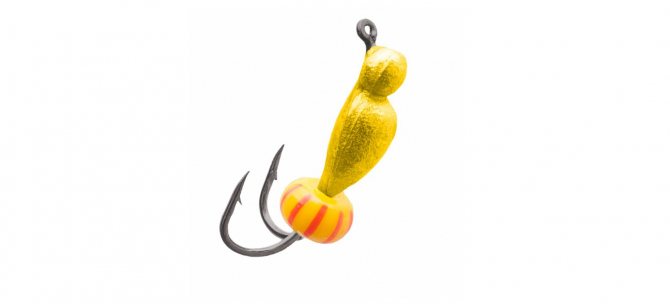
- “Ant”
is a jig for bream, white bream and roach for winter fishing. They are shaped like a real ant. During wiring, a game occurs with a small amplitude, similar to the movements of an ant. The most effective jigs of this type are made from lead. They weigh 0.3 g and are covered in black;
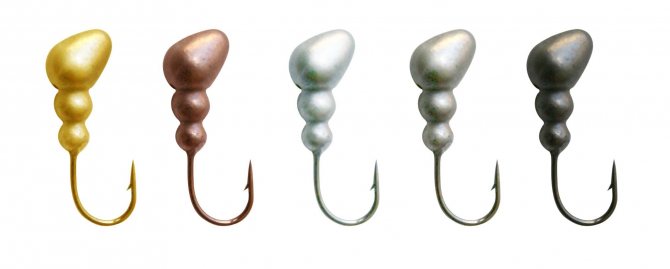
- “Donkey”
- the bait resembles cut coffee beans in appearance. When retrieving, it makes noise, which attracts predatory fish. Made from lead alloy weighing from 0.4 g. Usually painted green with black stripes;
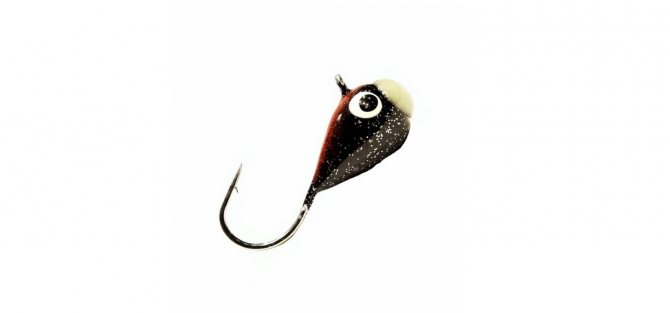
- “boat”
- the bait is intended for fishing in shallow waters. It lies on the bottom and looks like an insect digging the soil. In appearance it resembles a grain of wheat with a bevel cut. Made from polymer materials and lead. The jig weighs 0.3 g. They use galvanic coating in silver, black, and copper colors.
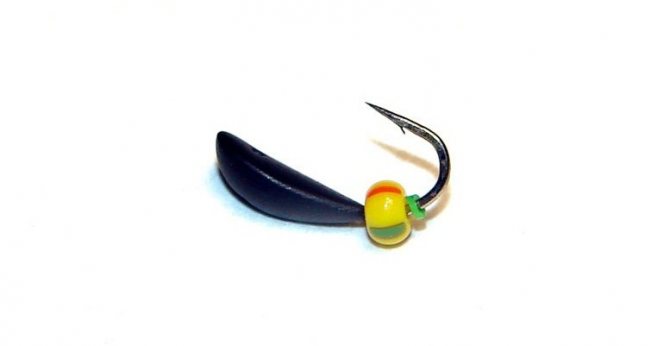
Nozzleless jigs. Types, description
- VK
When the time comes for active ice fishing, anglers rush to replenish their stocks with new models of baitless jigs. Many winter fishing enthusiasts prefer to make their own baits and achieve excellent results in this field. But making a catchy bait is only half the battle; it also needs to be presented correctly.
Simple jig "Devil"
Jig "Devil" simple weight - from 0.3 g. The most common type of jig with three hooks. Suitable for catching large roach, bream and other fish. A larger jig (from 1.5 g and above) is a good pike perch bait.
Mormyshka "Devil" compound
Jig "Devil" composite weight - from 0.8 g. Works well in strong currents and great depths when hunting for large fish (bream, ide).
Jig "Devil" curved
Curved jig "Devil" weight - from 0.5 g. It has a more varied game than the classic bait. Shows its best qualities most effectively in weak currents.
Mormyshka "Mini-Devil"
The “Mini-Devil” jig weighs 0.2-0.3 g. Thanks to its low weight and modest size, it attracts the attention of fish quite well, even if it is simply raised or lowered in the water column at a minimum speed. Unlike larger “devils”, “mini” ones can be used to catch small roach and perch in the coastal zone. A small piece of lead, equipped with three hooks, can help out an angler even during the most unstable bite.
Mormyshka "Twisted"
Mormyshka "Twisted" weight - 0.1-0.15 g. This ultra-light bait is especially good for catching medium-sized perch in shallow areas of low-flowing reservoirs.
Mormyshka "Bedbug"
Jig "Bedbug" weight - from 0.5 g. The bream jig works most effectively in the bottom layer. Low-frequency bait (60-80 vibrations per second) makes complex oscillatory movements in horizontal and vertical planes. It is used in standing and low-flowing reservoirs at great depths.
Jig "Medusa"
Jig "Medusa" weight - 0.3-0.6 g. Imitates the behavior of an aquatic organism, smoothly moving its legs. Fishing objects: perch, roach, bream, etc. Used in currents and in still water. The measured, quivering movements of the bait attract perch and large roach. Retrieving pace: smooth rise and fall with a small amplitude of nod oscillations.
Mormyshka "Tenka"
Jig "Tenka" is a large jig (1.5-2 g), more like a spoon, designed for catching perch, ide, large roach (on the last ice). Used in weak currents and standing water. “Tenka” is played like a regular jig, with a frequency of two to three vibrations per second and with increased amplitude. After three or four retrieves, it is useful to make one or two strokes, working the bait like a spinner.
Mormyshka "Cobra"
Jig "Cobra" for perch and ide; weight -0.5-0.8 g. Wiring - energetic “sawing” with fast vertical movements.
Mormyshka "Goat"
The Goat jig is a very common bait; weight - 0.3-0.8 g or more. Suitable for most winter active fish. The body of the bait in most models has a smooth bend. The inside of the “goat” is in most cases made of copper or brass foil and polished to a shine. The outer surface of the body is painted black or dark green. With correctly selected wiring, the game of the “goat” resembles the movements of an amphipod. This technique is effective: a fairly heavy jig crashes into the ground and begins to vibrate quickly, then with an amplitude of 34 mm it comes off the ground and begins to rise. The wiring speed can be either medium or fast.
Movable jig "Goat"
The “Goat” jig has a moving mass of 0.5 g. It has a more varied game. An additional game element in the form of large beads increases the chances of catching a “white” fish.
Mormyshka "Chain"
The “Chain” jig is a classic no-attachment jig. Its shape and size are selected in such a way that during wiring it produces the highest vibration frequency (over 200). This requires the fisherman to have certain qualifications. The bait, vibrating at a high frequency, is slowly and smoothly raised to a distance of 1 m or more from the bottom, then lowered in the same way. Very often bites occur at the top point of the rise. It is recommended to sometimes slow down the rate of oscillation of the jig, resuming the previous rhythm after 7-10 seconds. This technique often leads to success. Large perch (“humpbackfish”) are especially partial to the “chain,” but in the middle of winter they are half asleep. It is quite difficult to get him to try the bait; sometimes you have to sit over the hole for at least 15-20 minutes.
Mormyshka "Boat"
The “Boat” jig is used at depths of up to 2.5 m and works most effectively in shallow water. Weight - 0.3 g. More than half of the body volume of the jig is occupied by polymer material. Fishing objects: perch, roach, bream and other fish. The bait is balanced so that it works equally effectively with any fishing method. Swaying lazily as it rises slowly, it will attract wary roaches. With more intense fishing, it will have an irresistible effect on large perch and ide. A high oscillation frequency is a prerequisite for the successful use of most nozzle-less jigs. The “boat” allows you to reduce the oscillation frequency to minimum values without loss of catchability. This is very important, since not all anglers can maintain a high retrieve rate. The fish takes this jig boldly, mistaking it for live food. Due to its design features, the bait creates vibrations very similar to vibrations emanating from a real aquatic organism.
Flat jig "ant"
Flat jig "ant" weight - from 0.3 g. This modification of the classic "ant" has a more varied play pattern.
Mormyshka "Donkey"
Jig "Donkey" weight - 0.5 g. Used in currents and in standing water. Fishing objects: perch, roach, bream and other fish. The soft dark gray color of the lead alloy does not alarm finicky underwater inhabitants (which is especially important in “overfished” reservoirs). Deep “grooves” on the “back” create an interesting effect: when reeling, the jig makes noise, attracting fish from afar. The bait works quite successfully in gentle currents; the fishing is carried out near the bottom. Using the force of the current, tapping the bottom in small “steps”, the jig can be forced to move further and further away from the hole. Thus, a significant bottom area of the reservoir is fished, which significantly affects the catch. “Scratching” along the bottom and raising clouds of turbidity, the “donkey” provokes both pike perch and bream to bite.
Mormyshka "Ant"
Mormyshka "Ant" weight - from 0.4 g. It is possible to successfully catch the "ant" in large reservoirs. Before the flood, roaches begin to concentrate at the mouths of rivers flowing into the reservoir. The movement of the roach takes on a massive character, and it begins to move upstream of the river. Having encountered an “ant” with a black body and a white bead as a bait on its way, a large roach greedily grabs this “decoy.”
Mormyshka "Motylevaya"
Mormyshka "Motyleva" weight - 0.15-0.2 g. Ultra-light shallow-water bait with an elongated hook shank. The main working element of the bait in this case is a plastic bloodworm. The wave-like vibrations of the silicone tip of the imitation bloodworm, mounted on the hook of the jig, have a favorable effect on the bite. A medium-sized fish swallows the bait with great pleasure. Small roach pays increased attention to the oscillating silicone tail, pulling the plastic bait off the hook, which causes many empty hooks.
Mormyshka "Moth"
The moth jig has a low mass (0.1 g) and is used in the smallest places. Thanks to its segmented body, the bait resembles a large bloodworm. When fishing for perch, the “moth” is used at a hard, aggressive pace. Sometimes the perch bites sluggishly on a jig with a bait, while at the same time the bites on a “moth” are more decisive. Retrieving is carried out by lifting the jig up to the very edge of the ice, then slowly lowering the bait to the bottom, and the process is repeated. Sometimes, especially on frosty days, the activity of the perch increases, and it boldly swallows the “moth”, and the nod detects a sharp bite, as if on a spinner.
Mormyshka "Drobinka"
The “Drobinka” jig is articulated, weighing from 0.3 g or more. Quite a universal bait. Depending on the performance, it actively plays at different depths and attracts a variety of fish.
Jig with beads
Jig with beads at shallow depths and in the absence of current, some fishermen use a tungsten jig of a streamlined shape, weighing 0.2 g, equipping it with two relatively large plastic beads. The bait does not look very presentable, but it is catchy. Yellow and white colors of plastic baits attract roaches well. The game of this “reelless” jig is significantly influenced by the movements of the beads, which to some extent compensates for the intermittent movements of the jig itself. The body of the bait, as it were, sets the main tone of the game, “swinging” the voluminous but light baits.
Jig "Ant" tungsten
Tungsten jig "Ant" weight - up to 0.6 g. Used at significant depths. Thanks to the low frontal resistance, it can work stably in medium-force currents. Effectively used when fishing for bream, ide, large perch in holes with weak currents adjacent to river islands.
Mormyshka "Fly"
The “Fly” jig weighs 0.5 g. A hook No. 3 with a slight overlay in the fore-end area is soldered to a copper or silver-plated polished crown. Fishing objects: perch, medium-sized roach (along the first ice). During an accelerated rise, the jig moves away from the hole, and the excited perch willingly grabs the shiny “fly”. Sometimes the “fly” is jerked sharply several times, as a result of which it makes wide circular movements. If you return to normal fishing after this, you can provoke another apathetic perch to bite.
Ant jig "goat"
Ant “goat” jig weighs 0.15-0.17 g. This unique symbiosis of two designs has proven itself to be excellent when catching active roach and perch. The jig has a curved cut located in the upper part of the body.
Mormyshka lead body of an “ant”
Jig - the lead body of the “ant” consists of three segments arranged in an arcuate manner; weight - 0.15 g. The largest segment has a flat cut. This feature allows the jig to make additional vibrations in the horizontal plane. The game is more lively than that of an ordinary “ant” and has an excellent effect on the catch.
Mormyshka "Donnaya"
The “Bottom” jig weighs 0.2 g. The weight of the “reelless” jig is made in the form of a disk with a flat bottom. A hook with a plastic imitation of a bloodworm is movably attached to the eye of the jig body. “Bezmotylka” is designed for fishing in the bottom layers of water. If the jig begins to hit the bottom, nearby fish watch what is happening with interest. When the “bottom fish” slowly emerges from the cloud of rising turbidity, it immediately finds itself in the mouth of a curious perch. The jig is not raised above 5-7 cm. In addition to roach and perch, it is good for catching bream in gentle currents. The movable hook is fully equipped to meet fish from different directions. In large lakes, towards the end of winter, the stomachs of large perches are filled with black bugs. For a reason unknown to me, water insects accumulate under the ice in large quantities. Perches, having discovered an accumulation of easily accessible food, radically rearrange their diet.
Lightweight tin jig
A light tin jig (weight - 0.15 g) shows a phenomenal result in such conditions. With sharp swings with an amplitude of 57 cm, the “rewinder” makes throws in the horizontal plane, reminiscent of the movements of a small bug. The perches present nearby do not ignore the daring behavior of the small “insect”.
Mormyshka "Cone"
Jig "Cone" lead jig; weight - 0.15 g. Well-balanced design responds equally well to different wiring rates. Large beads have a noticeable effect on the movements of the bait. The “cone” is universal; you can use it to conduct reconnaissance in an unfamiliar body of water.
Mormyshka "Lentil" made of plexiglass
The “Lentil” jig made of plexiglass is placed on a separate leash 5-10 cm above the main bait. Works in tandem with the “devil” or any other “mothless”. Due to its small mass (less than 0.1 g), the fish easily draws it into its mouth and on some days more than half of the bites occur on the “lentil”.
Mormyshka "Malek"
Jig "Malek" is a large lead jig (weight - 0.6-0.9 g) for river fishing. Features of the package: a strip of white goat hair is glued to the back of the bait. A section of a river with a moderate current is examined using the method of stepwise wiring, floating a jig downstream. Fishing objects: pike perch and large perch.
Brass jig "bug"
Brass jig "bug" (weight - 0.3-0.5 g) on pebble river riffles. Fishing becomes especially successful when you manage to find a small pit located behind a decent boulder.
Mormyshka "Pendant"
The “Pendant” jig is an almost weightless design consisting of a hook No. 3.5 and soft plastic balls. Used in combination with a heavier lower jig (“devil” or “goat”). It is great for catching almost any available fish.
Mormyshka "Strelka"
Jig "Strelka" weight - 0.2 g. A fly with three tail tassels is tied to the shank of the hook. “Strelka” performed well on a rocky bottom in places with weak currents. It happens that the bait knocks on some overgrown stone located directly under the hole. In such a situation, bites follow one after another. The “arrow” sliding along the hard slope of an underwater obstacle resembles the movements of a natural prototype (dragonfly larva).
Jig "Bormash"
The Bormash jig is similar to a crustacean that lives under the boulders of river rapids. "Bormash" is effective in closed reservoirs, backwaters and reservoirs. Allows low-frequency wiring (90-100 vibrations per second). A synthetic tape is wound around the lead body of the jig. The fish reacted very favorably to such an innovation. "Bormash" has proven itself well when catching perch, roach and bream.
Mormyshka "Caterpillar"
Jig "Caterpillar" weight - 0.3 g. Lead wire is wound onto a hook No. 3.5 with an elongated shank; the interturn space is filled with squirrel fur fibers. As a result, the “caterpillar” makes smooth, slow oscillations during the drive, which cause confident bites from roach and bream. However, due to the increased resistance of the aquatic environment, immersion at the starting point of the wiring occurs slowly, so the “caterpillar” is effective mainly at small and medium depths.
Hanging hook
The advantage with a hanging hook is the high mobility of the main attracting element. During periods of increased feeding activity, perch eagerly grabs a hook wagging in all directions with baits strung on it.
Related articles:
How to fish with girders
Finding and catching perch in winter
Horizontal jigs - balancers
Mothless "Goat". Making tackle
Jig equipment
Every fisherman knows that the correct jig equipment guarantees success in fishing.
For winter fishing you need special equipment, which we will look at below.
Fishing rod
The winter version of the fishing rod is compact and simple in design.
Different models are used for fishing:
- regular fishing rod - includes a handle made of lightweight material, a reel for fishing line and a whip up to 400 mm long. The whip is selected according to the type of fish;
- A “filly” is a fishing rod without a reel, so a fishing line is wound around the handle. A replacement whip is provided for catching small fish: roach, perch, smelt;
- “balalaika” - the reel is located inside the handle and a whip is attached to it. The fishing rod weighs 15 g. The whip can be easily changed to select a certain stiffness.
Nod
A nod is an element of equipment that signals a bite and ensures the bait plays. This is a spring that is attached to the whip with a clamp or improvised materials.
Important!
The choice of nod must be approached thoughtfully. A very rigid guard turns the fishing rod into a stick, and a very flexible nod dangles from the current and wind. A fisherman should have different types of nods in his arsenal.
For fishing with a reelless bait, soft guards are used. They have high elasticity, as they are made from lavsan or thin plastic.
fishing line
The attractiveness of the bait depends on the thickness of the fishing line. The fishing line for winter jig fishing should be thin and strong. Firstly, in winter the water is clear, which means the fish can see the thick fishing line well. Secondly, a thick fishing line with a light jig plays unnaturally. At the same time, a thin fishing line may not support the weight of the fish, and can easily get tangled in the wind.
The optimal line for a jig for perch in winter fishing is considered to be 0.1 mm, and a jig for winter fishing for bream is 0.12 mm.
Mormyshka
There is a special hole for attaching the jig at a certain angle. A fishing line is passed through it. A fastening is considered reliable when a fishing line is tied to the shank of the hook, and then the sting points upward. There are jigs that have a special eyelet for fastening.
How to tie a jig
Every fisherman should know how to tie a jig so as not to lose his catch. The fishing line in a knot will be strong if it is almost not bent and the knot is not tightened too much.
You can quickly tie a jig in the following way:
- 10 cm of fishing line is passed through the hole or ring of the jig;
- they want a small loop, and then press it to the shank of the hook;
- with the tip of the fishing line, apply 5 turns to the fore-end and loop;
- the free tip of the fishing line is passed into the loop;
- the knot is moistened and tightened;
- The ends of the fishing line are cut off near the knot.
Important!
To prevent the fishing line from rubbing against the sharp corners of the jig, an elastic tube is inserted into the hole.
Mormyshka Caddisfly from a light bulb
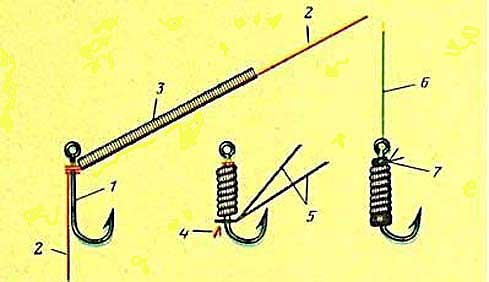
A ready-made homemade caddisfly jig from a light bulb filament is shown in the drawing on the right, but before you start making it, think about whether a reelless vertical bait is suitable for your fishing trips.
The reelless caddis jig is quite difficult to manufacture, but, judging by the reviews of its inventor L. Ashikhmin, it is a good winter bait for catching fish.
In order for a homemade jig to look like a butterfly larva, select the appropriate bait kit, which consists of the following elements:
1 - hook No. 5-6 (Russian numbering);
2 - wire with a diameter of 0.3-0.4 millimeters;
3 - spiral of a faulty incandescent light bulb to form the body of a caddisfly;
4 - shows the ends of the wire pressed to the shank of the hook of a homemade jig;
5 - nylon thread;
6 - fishing line 0.10-0.12 millimeters for tying a homemade reelless jig to the tackle;
7 - black silk thread is used to form the head of a caddis fly.
Making a caddis jig
You can make a jig similar to a caddis fly as follows.
First, prepare a spiral light bulb with a power of 100-150 watts.
Thread about 60-70 mm of soft copper wire into the ring of the hook of the future reelless jig, the smaller part of which stretch along the shank of the hook clamped in a yew.
Wrap a large piece of wire around the shank with two turns below the hook ring. After this, we make the body of a caddisfly jig from wire and a spiral of a light bulb.
We place the spiral of a burnt-out light bulb on the wire and wrap it around the fore-end of the hook of a homemade jig until it becomes hooked. We cut off the excess spiral. We twist both ends of the copper wire and cut off the rest with side cutters.
Making the head of the caddis jig
To make a caddis fly head, we wind a black nylon thread onto a twist of copper wire, and melt the winding with a match. This will prevent the light bulb spiral from sliding onto the hook of the reelless jig.
Below the ring of the hook we wind several turns of black silk thread, tie it with knots and cut it, leaving short ends. The manufactured head and antennae of a homemade caddisfly can be impregnated with waterproof glue.
"Caddisfly" is a light bait. Therefore, you will have to fish with a homemade reelless jig using a thin fishing line in shallow places in reservoirs.
A home-made side pendulum nod, which was invented to impart high-frequency vibrations to reelless jigs, will help to make a caddis fly jig vibrate at a high frequency like no other.
Jig fishing technique
Fishing conditions and reservoirs differ from each other, so the fishing technique with a jig is selected experimentally in each case. Before starting the retrieve, check how the fish reacts to the downward movement of the jig. If there is a bite, then you can start the game.
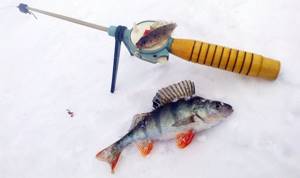
Conditional winter wiring for different types of fish is as follows:
- Bream wiring.
The jig is tapped on the bottom, and then the bait is evenly lifted and gently swayed with a nod. Raise it a meter, pause and make a control hook. The game continues up to three times. - Perch wiring.
The jig is raised slowly, and at the same time creates oscillatory movements with low amplitude and high frequency. - Carpenter's wiring.
The bait is raised with vibrations of small amplitude and medium frequency. At the top point, a pause is made, a control hook is made, and then the tackle is lowered step by step to the bottom. As a rule, roaches bite on descent.
For all types of fish, regardless of the type of retrieve, at the end of the lift, a stop, pause and control hook must be performed.
How to make a jig with your own hands
There is a large selection of jigs on sale, but experienced fishermen prefer to make jigs for winter fishing with their own hands, as they believe that they are more catchy than factory models.
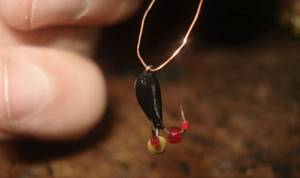
Jigs are made in the following ways:
- Sawing.
This is a very simple way. Using a file, a jig body of a certain shape and size is formed from a copper or bronze blank. Then solder the hook and paint the bait in the desired color. - Soldering.
The shank of the hook is inserted into the heated solder. After the solder has hardened, the desired jig shape is formed and then painted. - Forging.
The lead blank is given a certain shape with a hammer. Then a recess for the hook is cut out in it with a hacksaw. At the final stage, the hook is soldered in and the jig is painted. - Casting.
This method is used to obtain high quality rewinder. Prepare a mold from two parts of plaster or wood, and place a hook in it. Pour in hot tin or lead and allow to cool. After processing they paint.
In general, the popularity of winter fishing is constantly growing, which means jigs are becoming more in demand. Don’t be afraid to experiment with passive bait, then fishing will be exciting and successful. Good luck!

